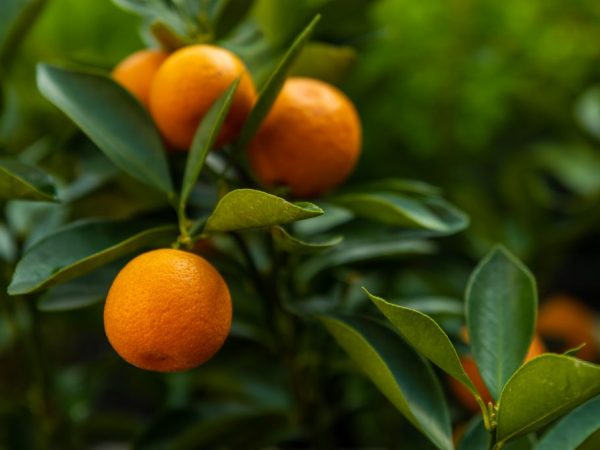How to feed citrus fruits at home
Growing citrus plants in an apartment requires providing them with regular and high-quality nutrition. The growth, flowering and fruiting of indoor trees depend on it. The modern market for such products offers different fertilizers for citrus plants.

Fertilizing citrus fruits at home
Early spring nutrition
In the spring and summer, plants at home require special care. At this time, it is allowed to feed them with several components:
- Nitrogen-potassium fertilizers are applied every 10 days.
- 5 days after the introduction of nitrogen and potassium, superphosphate and slurry are added. This is done no more than 2 times a month.
- Once a month, they are fed with slurry.
Nitrogen is found both in organic matter and in mineral preparations. It provides intense green growth. Potassium promotes abundant flowering and high-quality fruiting of citrus fruits.
In addition to the above preparations, a solution of horse manure is used. This is one of the best homemade citrus feed. 100 g of the substance is poured into 1 liter of water and infused for 15 days. In the absence of horse manure, cow dung or bird droppings are used at a concentration of 40 g per 1 liter of water.
Of the mineral fertilizers containing nitrogen, carbamide is suitable for citrus fruits. The crystals are dissolved in the following concentration: 1.5 g of substance per 1 l of water. Also complex fertilizers are well suited for decorative deciduous plants, which include nitrogen.
Preparation for wintering
At the end of August - at the beginning of September, phosphorus-potassium supplements of domestic citrus plants are used. These components contribute to the completion of the growth process, strengthen young shoots, saturate the plants with the necessary components and preserve the decorative effect of the crown.
The best drugs are superphosphate and potassium salt. Complex preparations are used with an increased content of phosphorus and potassium and with a reduced content of nitrogen. They are introduced both root and foliar. Each meal involves the use of a different dosage of substances. It is written in the instructions on the box.
Winter meals
If the tree is in cool room conditions (8 ° C-12 ° C) and without additional lighting, it makes no sense to feed it. In a warm environment at a temperature of 18 ° C-20 ° C, the tree is fed with the above preparations, only the concentration is 3 times less. The frequency of application is 2 times a month.
The best fertilizer in the winter is a complex fertilizing for citrus fruits. They are introduced alternating, both root and foliar.
Top dressing during flowering
To ensure long-term flowering and, as a result, get a good harvest of fruits, a specialized complex fertilizer for citrus fruits is required.
Fasco

Top dressing improves soil quality
One of the best preparations is Fasco bait. This flowering plant fertilizer provides:
- long flowering;
- abundant fruiting;
- improves the quality and composition of the soil;
- stimulates the growth and development of the root system;
- increases plant immunity.
Top dressing "Fasco" is applied according to the instructions on the package.
Bona forte
The complex preparation "Bona Forte" contains 3 components at once: nitrogen, phosphorus and potassium. The prepared solution, in accordance with the instructions, is used from March to October once a week and from November to February. Do this once a month.
Fertilization with Bona Forte can be done both root and foliar, observing the concentration indicated on the package.
Nutrients strengthen the immunity of plants, contribute to their full growth, flowering and fruiting.
Top dressing with non-traditional preparations
Industrial preparations can be replaced with homemade products:
- Instead of superphosphate, bone (carpentry) glue is suitable. The method of application is simple: 2 g of the substance is poured into 1 liter of water, boiled until the gelatinousness disappears. The soil is watered and loosened after a few hours.
- Sludge helps to compensate for the lack of nitrogen. The top layer of soil is removed and this component is laid instead. Pounded quinoa leaves are a good substitute for nitrogen.
- Black tea leaves left over after brewing are a valuable source of potassium, phosphorus, sodium and magnesium. Usually they are laid out on the surface of the ground. Some people use brewed leaves when transplanting the plant.
- Phosphorus-potash fertilizers are replaced with wood ash. 15 g of the substance is dissolved in 1 l of water.
- To compensate for the lack of iron, rust from old metal products is used. It is sprinkled on the surface of the soil, then watering is carried out.
- Potassium permanganate solution makes up for the lack of manganese and potassium in the soil. This substance not only nourishes the plant, but also disinfects the soil. The preparation instructions are simple: 5-6 grains of the substance are dissolved in 1 liter of water. The resulting solution is brought to a volume of 1.5 liters. Indoor trees should be fertilized in the evening, no more than once a month.
- To saturate the soil with calcium, use ordinary plaster or lime. Method of application: sprinkle the soil around the trunk circle with a white substance, then water it.
How to identify a lack of fertilizer
With a lack of nitrogen in the soil, the plants lose their decorative effect: the leaves turn pale, turn yellow, and crumble. The plant blooms poorly, the fruits are formed underdeveloped.
If indoor citrus (lemon, lime, tangerine) leaves dull, and the peel of the fruit becomes too thick and wrinkled, they lack phosphorus.
With a lack of iron, chlorosis develops. The leaves turn pale, turn yellow, the peel of the fruit becomes pale yellow. The apical parts of the shoots dry out.
Conclusion
Depending on the season, different fertilizers are used for citrus fruits. If you follow the nutritional regimen and dosage, it is easy to grow healthy, beautiful and fruiting trees at home.


